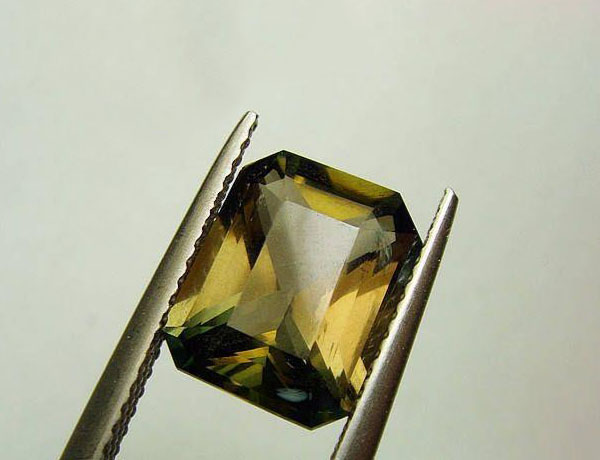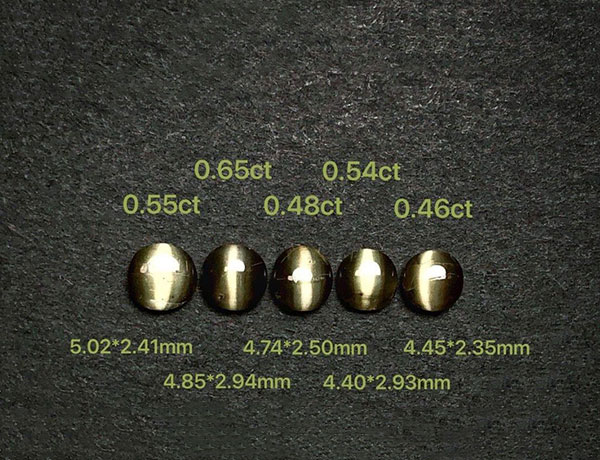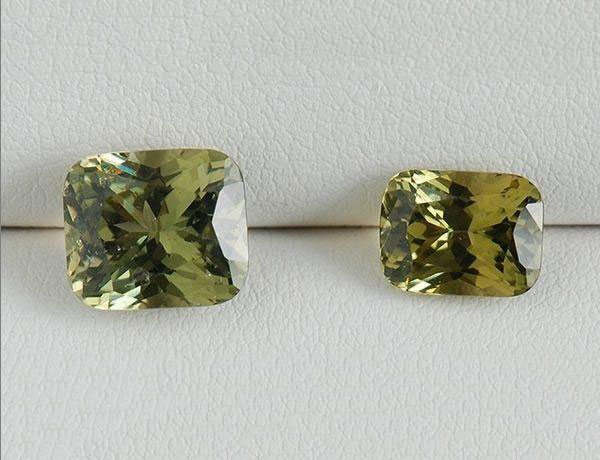Kornerupine is also known as “Kornerupite” and “Prismatine”.
Kornerupine was first found in Greenland and later was identified by Danish scientist Kornerup AN for the first time.
Kornerupine is a rare mineral, which is very bright after polishing, so it is regarded as a precious gem by collectors.
Kornerupine is a complex borosilicate containing magnesium, aluminum and iron. It is produced in crystalline schist, pegmatite and its sand ore, and is often symbiotic with sand lineite, corundum, etc.
Kornerupine belongs to the orthorhombic system. The crystals are usually 2-5cm long columnar. The colors are mainly yellow, green, blue, brown and light pink, rarely colorless, usually in light tones.
Kornerupine has strong pleochroic, sometimes green, yellow and brown can be observed in the same crystal with naked eyes. Kornerupine is brittle, has two groups of complete cleavage, and is Transparent to slightly transparent, with glass luster.
Transparent crystals can be cut into faceted gemstones. Fibrous aggregates are often ground into gemstones with cat’s eye effect.
It is mainly produced in these areas:
- Myanmar, which produces green crystals;
- Sri Lanka produces yellowish-brown and light-pink crystals, and Madagascar produces dark green and sea blue crystals.
- Kenya and Tanzania in East Africa produce emerald green crystals with the color similar to that of tsavorite, but the production is rare. The size of Kornerupine gemstones is usually 1-5 carats.

Basic Property of Kornerupine
The chemical formula of Kornerupine is Mg3Al6 (Si, Al, B) 5O21 (OH), which belongs to the orthorhombic system and the crystal is columnar.
1) Mohs hardness: 6-7.
2) Cleavage: two groups of complete cleavage.
3) Density: 3.28~3.45g/cm.
4)Optical property: inhomogeneous body, biaxial crystal, negative optical property. The optical axis angle is 3 °~ 48 °.
When the optical axis angle is very small, it shows the optical property close to the uniaxial crystal and presents an interference pattern similar to the uniaxial crystal.
5) Refractive index: 1.661~1.699, birefringence: 0.013~0.017.
6) Gloss: glass luster.
7) Color: yellow-green, blue-green, brown-green, yellow, brown, colorless, etc.
8) Polychromism: Moderate to strong polychromatic.
9) Transparency: Transparent to translucent.
Kornerupine variant type
Kornerupinecat’s eye

The gem with cat’s eye effect is made by grinding the Kornerupine crystal fiber aggregate.
Starkornerupine
A translucent to slightly transparent green brown Kornerupine variety with star effect produced in Mogu, Myanmar. The cause of the stars is not clear.
Physical characteristics of Kornerupine
Glass luster, transparent to translucent.
Pure Kornerupine is colorless, generally brown, yellow or green, yellowish green to brownish green, and blue-green. The common ones are mostly brown crystals or aggregates.
- The biaxial crystal has negative light, showing the illusion of a uniaxial crystal interference pattern.
- The refractive index is N=1.674 ~ 1.699, Nm=1.673 ~ 1.696, and Np=1.661 ~ 1.682.
- The birefringence rate is 0.012~0.017, 2V=20 °.
- The dispersion degree is 0.019.
- Pleochroism is generally strong, green to yellow, red-brown to light brown yellow.
- It can show ultraviolet long wave light and short wave light, but green varieties produced in Myanmar and varieties produced in East Africa emit yellow fluorescence.
- The absorption spectrum can show several weak bands, but usually can only be measured at 503 nm. It can show cat’s eye effect or rare weak starlight effect.
- The two groups are completely cleaved, with shell-like fractures,
- The Mohs hardness of 6-7;
- The density of 3.30 (ten 0.050, – 0.030) g/cm.
Occurrence and origin of Kornerupine
Kornerupine, lapis lazuli and sapphirin coexist in schist, pegmatite, granulite and placer ore.
- Gem-grade Kornerupine is mainly produced in Madagascar, Sri Lanka, Myanmar, Germany, Natal, South Africa and East Africa.
- The Kornerupine produced in Madagascar is a large dark green and sea-blue crystal;
- The Kornerupine produced in Sri Lanka is yellowish brown, greenish-brown;
- In addition to various colors of Kornerupine, Myanmar also produces a rare starlight Kornerupine in Mogu.
Main identification features

Magnified observation Kornerupine with gas-liquid inclusions and solid needle inclusions.
Kornerupine looks similar to dark green to light green brown tourmaline, olivine, diopside, topaz, sinhalite, enstatite, and smoky quartz.
Refractive indexes of sinhalite, olivine, diopside and enstatite are similar. However, the birefringence of sinhalite, olivine, and diopside is higher than that of enstatite. We can distinguish them by spectrum and optical properties.
Spodumene is similar to Kornerupine, while spodumene has a lower density than that of Kornerupine.
The absorption spectrum of Kornerupine has an absorption band at 503 nm.
The main identification of Kornerupine is based on color, refractive index, birefringence, pseudo-uniaxial crystal phenomenon, Pleochroism, relative density, etc., displayed by the refractometer.
The accurate discrimination of Kornerupine cat’s eyes, especially other gemstones with similar refractive index, such as enstatite and diopside cat’s eyes, depends on large test instruments.
Conclusion:
The name Kornerupine comes from the name of Danish scientist A.N. Kornerup.
Kornerupine, Cordierite and citrine coexist in crystalline schist, pegmatite and its placer. The main producing areas are Miandian, East Africa, Madagascar, Sri Lanka, etc.
Kornerupine has various colors, among which Kornerupine produced in Mogu also produces rare starlight.
Kornerupine in Madagascar is a large dark green or sea blue crystal; Kornerupine crystals in Sri Lanka are yellowish brown, greenish-brown and red gravel-like crystals.
